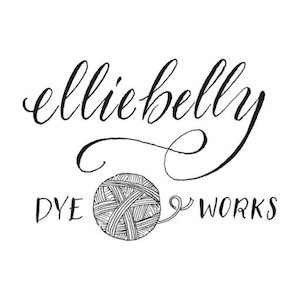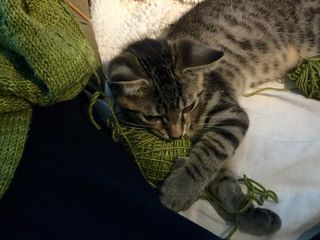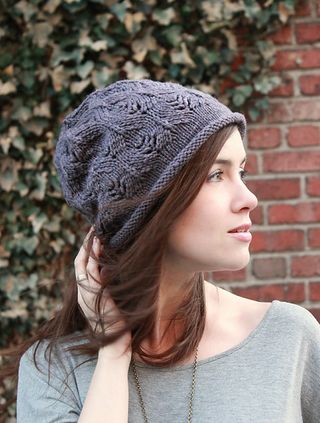Happy Saturday! I’m finishing up the last sleeve on Vodka Lemonade with a little help from a friend.
Tag: merino
Elliebelly’s Adventurous April KAL 2015 Begins
The Knit Along isn't actually beginning just yet, but I'm winding my yarn and gathering my notions so I will be all ready on April 1. Looking for a KAL to join? Our pattern, Antarktis, is a one skein project that is beginner appropriate and we are lots of fun to knit with! You can use any yarn you want, and, if knitting a scarf/shawl isn't your thing, we also have a stuffed animal and a "learn a new technique" category. Sign up for the Elliebelly group on Ravelry here, introduce yourself in the threads and feel free to join in with us!
I've selected my yarn after lots of back and forth. It's Elliebelly's MCN (merino/cashmere/nylon) High Twist in a fingering weight. It's a pale robin's egg blue called Lady Mary (if you watch Downton Abbey, you'll remember the dress that inspired the colorway!)
My runner up choice is this Elliebelly Seasilk in Jabot. I went with the Cashmerino blend because the Seasilk doesn't grow as much when blocked, and pattern designer Janina Kallio stresses the importance of selecting a yarn that will block well.
I'm all set. I've got my new Darn Pretty Needles all ready to go, along with my yarn in a pretty linen bag from Churchmouse. See you on Wednesday for the start of knitting nirvana as we all cast on.
Dyeing For Spring
I'm going to need a hat to wear on my travels this spring. I want something lighter weight than the hats I have managed to keep out of my children's greedy little hands and also a springy green color. Since I didn't seem to have anything the fit the bill in stash, I dyed this.
It's a new-to-me yarn, Kraemer's Maria, a 50% silk/50% merino blend with 225 yards in 100 grams. The yardage and the look are both about right for me to call it a worsted weight yarn. For patterns, I'm still deciding between a Plum Tree Slouch
(c) NNK Press (with permission)
and an Irving hat.
(c) Melissa LaBarre (with permission)
They are both tempting choices and I feel sure I'll end up knitting both of them. The yarn itself seems to almost completely lack a Ravelry presence, so I'm knitting blind here. But I tend to like Kraemer's yarns and this one dyed up beautifully, so I have high hopes.
A note about the dyeing process. I like to apply color to yarn in layers, rather than all at once, to get more organic color variation in yarns that aren't going to be level-dyed a solid color. This yarn was originally dyed a pale yellow and then overdyed with a blue that was a dilute almost-navy solution, before being glazed in a yellow-brown. Although I'm often asked is glazing is worth all the work, there is no doubt in my mind that the same principles I used to use in painting collage backgrounds are equally at work in dyeing yarn, and there is simply no substitute for carefully applied layers of dye, each of which makes the final color full and rich.
Works in Progress
The week I go back to work after the holidays is always a bad week for knitting (as much as it is good to be back with good friends and getting the job done). I manage to get in a bit of knitting when I wake up and a bit at night, so this week wasn't a total knitting loss. But progress was slow.
Thea Coleman's Vodka Lemonade pattern is my most challenging project at the moment. It's a sweater pattern knit in The Plucky Knitter's delicious Crew yarn, a merino/cotton blend. That is the collar that you see above. It's knit in seed stitch. I'm in the decided minority of knitters who enjoy knitting it. It's slow going and time consuming, but it's very pretty. At this rate, it will take me quite some time to finish the collar before I get on with the body of the sweater, but I don't mind at all.
Paddle Mitts are a Tin Can Knits pattern. Like the other patterns I've knit from this designer, the pattern is straightforward and the finished item is utilitarian. And I have managed to create a small disaster with what should have been a simple project. I decided to use my favorite skein of yarn, this beautiful skein of Plucky Scholar, which is a worsted weight blend of cashmere and merino in a rustic spin.
That would have been just dandy, had I seriously contemplated the fact that Scholar was a bit heavier than the yarn the pattern was written for and sized down, but no, I did not. That was okay in the body of the hand, where the ribbing made it work. But there was drama with the thumb and I overcompensated with rapid decreases after picking up the stitches for it. I've pulled that all out and am starting over for a thumb that works with the rest of the mitts. This will go into the man-sized pile for gift giving, darn it. I hope I have enough yarn to do a second pair for myself.
When The Plucky Knitter introduced her first collection of patterns, All Bundled Up, last weekend, I enjoyed looking them over and admired several enough to add to my Ravelry queue of patterns to knit this year. I even contemplated buying yarn for one of the sweaters in the near future. But then it hit. The Sugarloaf Infinity Scarf pattern was so tempting. It was written for my favorite yarn, Snug, and it just so happened I had the perfect colorways for it in my stash. So on my needles it went, and it's unusual little rib was an enjoyable knit while we watched a move on TV last night (The Life Acquatic with Steve Zissou, which you should watch if you haven't seen it and like slightly snarky, self-indulgent humor).
I have plans this weekend to work on my Olivia wrap, and I wanted to get in more work on Vodka Lemonade's collar, but I'm afraid Sugarloaf has captivated me, and may end up as the attention-getter in whatever time I have this weekend. Fortunately, it's cold outside and there is a lot of appeal to sitting inside where it is warm and this is hot tea and I can knit.
Gadabout: Knitting That Is So Much Fun I Can’t Wait To Do It Again
I liked knitting Gadabout a lot.
I like knitting cables and these were unique. And somehow, although I was able to memorize that pattern on the first repeat — something that almost never happens with me — it never got boring. Gadabout is one of those patterns where you want to do "just one more repeat" before you put it down for the night, so you keep going until it's done.
It does not hurt that this is in cashmere. It does mean that I haven't taken it off since it finished drying after a good wet blocking, which really brought out the pattern.
This is a go to pattern. I'd like to knit it next in The Plucky Knitter's bulky Snug — a cashmere blend. But I'd also like to do it in a gently variegated yarn, perhaps a Malabrigo Mecha version. I think it would also look great in Elliebelly Basilisk, a silk and merino blend, and I may need to dye some of that up in a wheat color to use as well.
Knitting The Cables And Lace Capelet
I finished up my Cashmere Gadabout last night. It's blocking and there will be photos later on this week. Once it was drying, I picked back up with my Cables and Lace Capelet, which has been languishing for weeks while Christmas knitting got finished. And I'm so glad that I did! This project has a lot of virtues.
First is the yarn. I love Madeline Tosh. Sometimes, I cherish her skeins so much I become hesitant to knit with them while waiting to find the perfect pattern. But this yarn, her Super Bulky ASAP in the Weathered Frame colorway, was ordered just for this pattern and went straight onto my needles when it arrived.
The second virtue of this pattern is that the yarn knits up fast and pretty in the super bulky weight. I'm not a huge fan of knitting on large needles, and the size 11s are at the outer edge of comfortable knitting for me, but still within it. And overall, they are worth dealing with because it is so stinking fun to watch this pattern take shape, so quickly.
The third virtue is that it is making me feel very accomplished. If you've looked at this pattern before you know that you knit the bottom band and then, after grafting the ends together, pick up stitches to knit the body of the capelet. I'm notorious for avoiding picking up stitches, but have been gently encouraging myself to do so over my last few projects. I'm happy I've been doing that, as last night, I picked up the 133 stitches around the edges of the band without a hitch and went onto the lace. Success!
My gauge is good, even in the round. But I'm aware of pattern notes that say this project comes out too small for an adult, even though the sample project is beautiful and clearly adult sized. It's difficult to get a sense with it all bunched up on the needles, but I'll likely take it off on some waste yarn once I get a foot into the body to get a sense of whether I need to make some adjustment. Hopefully once finished, my notes on sizing will help anyone who wants to knit this down the road to get a sense of how it fits. It's such a beautiful project and this is an ideal yarn.
Dyeing Yarn with Natural Dyes. Part One.
You will never guess. What natural dyestuff do you think I dyed these yarns with? It's definitely not an obvious choice, unless you've done this before, but all three of these skeins were dyed in a vat prepared from black beans.
Here they are, soaking in the kitchen. I use a pot with a strainer so I don't have to fish all of the beans out after the "juice" is ready, and since this is nothing but black beans, I have none of the usual worries about working in the kitchen.
I'll include tutorial notes on the steps I took, in case you want to dye along with me. I eye-balled the amount of water I would need to cover my skeins, and after rinsing the dust off of the beans, covered them in water, stirred them up, and left them to soak. This batch soaked for about two and one-half days.
The day before I wanted to dye my yarn, I pulled it out to mordant. The mordanting process makes it possible for the dye molecules to stick to the yarn molecules, much as in commercial wool dyeing where citric acid is used in the process. There are a number of mordants available for use with natural dyes. Here, I'm using aluminum sulfate, which, although considered safe, means we're back to using designated dye pots and a mask for mixing.
We're using skeins of three different yarn bases here, because natural dyeing produces fascinating and often unpredictable results on different fibers. On the left is a skein of Elliebelly Pixie Superwash Merino. The middle skein is Elliebelly Panda, a 50/50 silk bamboo mix. The final skein is undyed Malabrigo Mecha, which is a single-ply Merino, that is not superwash.
Here they are in the mordanting bath, with 5 tablespoons of Alum and a tablespoon of kitchen grade Cream of Tartar, which acts as a mordant/brightener. I take close to an hour to bring the submerged yarn to a temperature where the yarn is not quite simmering. Then, lid on but off the stove, the pot sits until the yarn is completely cool before going into the dyepot. This is particularly important in this case, as dyeing with black beans is a cold process, and the colors gray out if heat is applied.
Remember to use your stove fan if dyeing in the kitchen. (With thanks to my husband for the lovely magnet that graces the hood of our stove).
Tomorrow, we'll walk through the dye bath and admire the finished yarn in Part Two.


